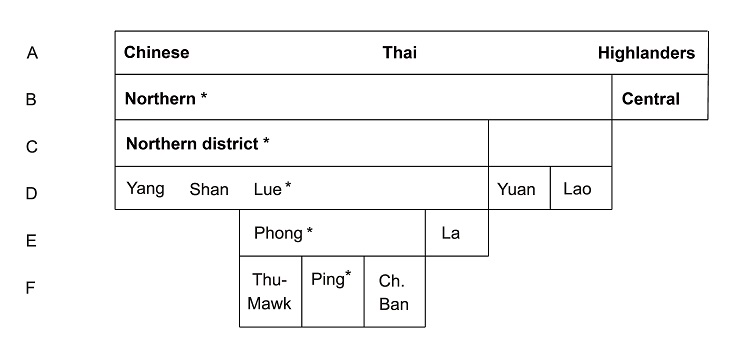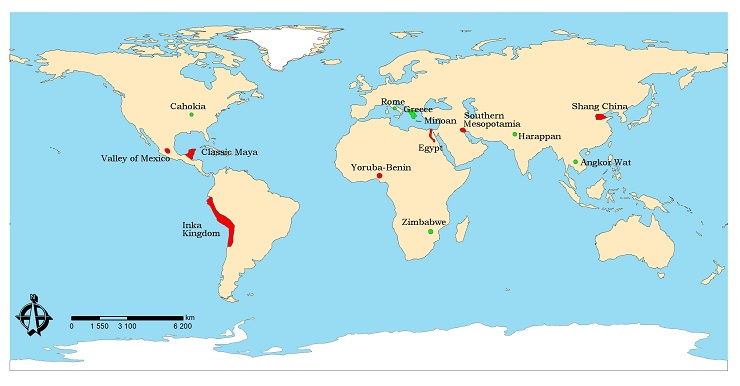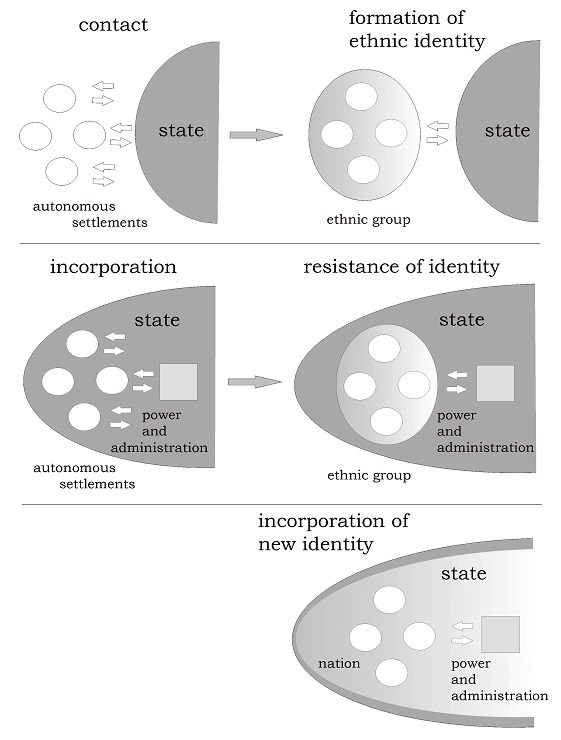What distinguishes archaic societies from the Western world, is not the manner of livelihood, but the qualities that stand in the background, hidden behind the artefacts, their economies and their settlement system. Although researchers have sought for a definition of otherness since the mid-19th Century, no wider acceptance of criteria across different sectors has occurred. Therefore, it is very difficult to draw the line as to the point at which during their historical evolution different cultures ceased to be archaic societies.
 |
| Classification of different levels of ethnic terminology in the Ban Ping area in Thailand. After Moerman 1965, 1224. |
To provide an example, allow us to present two possible causes of change in the gist of social actors in archaic societies - these are the emergence of a complex power-political unit (i.e. a state) and the existence of ethnicity. In fact, it appears to be a part of one single large-scale transformation process.
When did ethnicity emerge? Traditionally talked about is the ancient ethnicity and the historians considered it as representing a social category that corresponds with the standards of our own world. Newer critical works, however, tend to indicate that this level of identity either had a significantly different content in antiquity or that it never existed at all. This criticism is based, inter alia, on the written Mesopotamian records, in which such terms as Sumerian, Akkadian, Amorite, etc. are used, they apparently were not referring to ethnicity, as is sometimes assumed. The Mesopotamians certainly distinguished between themselves and others, but this difference was not viewed on an ethnic nor a racial basis; in fact it was a differentiation in accordance with belonging to a settled urbanised habitus or, vice versa, to a nomadic life.
The second example from ancient times is represented by the Roman Empire. In written sources of that time, although ethnic terms exist, they are used in relation to societies that are outside the borders of the Empire. This categorisation is primarily important in regard to the control of “other” populations that need to be divided into smaller groups. If no smaller units exist or if the government authority is unable to detect them, it is necessary to create an autonomous classification. Usually such a system is based on classifying the population in accordance with certain dominant traits that characterise them, such as their language, their anthropological type, in regard to their culture, economic factors or the territory in which they live. This does not mean that these are always newly created social identities; rather they may represent a distortion of existing ones. Regardless of whether we accept the view that the dominant features of ancient ethnicity are purely fictitious and stem from the administrative needs of imperial policy, or whether we admit the existence of their roots in pre-ethnic solidarity relationships, we should certainly be able to perceive the problematic nature of the uncritical acceptance of the ethnic contexts of historical sources.
 |
|
Map of some archaic states in human history. Red colour highlights locations of seven early civilizations according to Trigger 2003, p. 30. |
Why is such a high degree of emphasis generally placed on the relationship between ethnogenesis and the emergence of complex social formations? Because through the emergence of the state a new factor entered the process of both individual and group identity, which represents an unrelated form of ties that are typical of ethnic belonging. If we understand ethnicity as a form of identity that goes far beyond family, village or clan, at the same time we must also face the fact that none of these small units will ever voluntarily give up its sovereignty. The State acts as an inevitable source of pressure that acts on the political, economic and ideological levels of its surroundings. New social ties are created to the State, to its symbolism and to the ruling class that are all detached from any kind of kinship. If the process of creating the State succeeds, the nation will emerge safely, otherwise there will be a greater deepening of the original identity of the group and of its definition within the new system of governance.
To obtain a comprehensive picture of the historical face of ethnicity is very problematical. First, it appeared that the historians and linguists were able to trace the ethnic identity of myths, chronicles, traditions, memories and artefacts, though, of course, entirely in accordance with their current needs at the time. Secondly, the form of the past identity(ethnicity) is distorted by manipulation, both in the context of its time on the part of the then “creators” of ethnic identity, personified by warlords and kings, and by the contemporary demons of our political world, namely racism, nationalism and chauvinism. Ethnic identity probably only began to exist in relation to some broader socio-political entity, which usually would be the State. Together they then constitute a series of transformations that distort the original forms of archaic societies.
|
|
| Mechanism of ethnic identity genesis. Contact of pre-state autonomous units with a complex state is considered a fundamental factor (after Kvetina 2010, 649). |
Want to learn more?
- Bahrani, Z. 2006. Race and Ethnicity in Mesopotamian Antiquity. World Archaeology, Vol. 38, No. 1:48-59.
- Brass, P. R. 1985. Ethnic groups and the state. In Ethnic groups and the state, ed. P. R. Brass, 1-56. London: Croom Helm.
- Derks, T., and N. Roymans (eds). 2009. Ethnic Constructs in Antiquity. The Role of Power and Tradition. Amsterdam: Amsterdam University Press.
- Earle, T. K. 1991. Chiefdoms: power, economy and ideology. Cambridge and New York: Cambridge University Press.
- Emberling, G. 1997. Ethnicity in complex societies: Archaeological perspectives. Journal of Archaeological Research 5:295-344.
- Emberling, G., and N. Yoffee. 1999. Thinking about ethnicity in Mesopotamian archaeology and history. In Fluchtpunkt Uruk: Archaeologische Einheit aus methodologischer Vielfalt: Schriften für Hans J. Nissen, eds. H. Kiihne, R. Bernback, and K. Bartl, 272-281. Rahden: Marie Leidorf.
- Eriksen, T. H. 2007. Antropologie multikulturních společností. Rozumět identitě. Praha: Triton.
- Lucy, S. 2005. Ethnic a cultural identities. In The archaeology of identity. Approaches to gender, status, ethnicity and religion, ed. M. Diaz-Andreu, 86-109. London and New York: Routledge.
- Nagel, J. 1994. Constructing Ethnicity: Creating and Recreating Ethnic Identity and Culture. Social Problems 41/1:152-176.
- Whittaker, D. 2009. Ethnic discourses on the frontiers of Roman Africa. In Ethnic Constructs in Antiquity. The Role of Power and Tradition, eds. T. Derks, and N. Roymans, 189-205. Amsterdam: Amsterdam University Press.
- Woolf, G. 1997. Beyond Romans and Natives. World Archaeology 28/3:339-350.
- Yoffee, N. 1990. Before Babel: a review article. Proceedings of the Prehistoric Society 56:299-313.
- Yoffee, N. 2005. Myths of the archaic state: evolution of the earliest cities, states and civilizations. Cambridge and New York: Cambridge University Press.
 Archeologické 3D virtuální muzeum
Archeologické 3D virtuální muzeum

.jpg)
